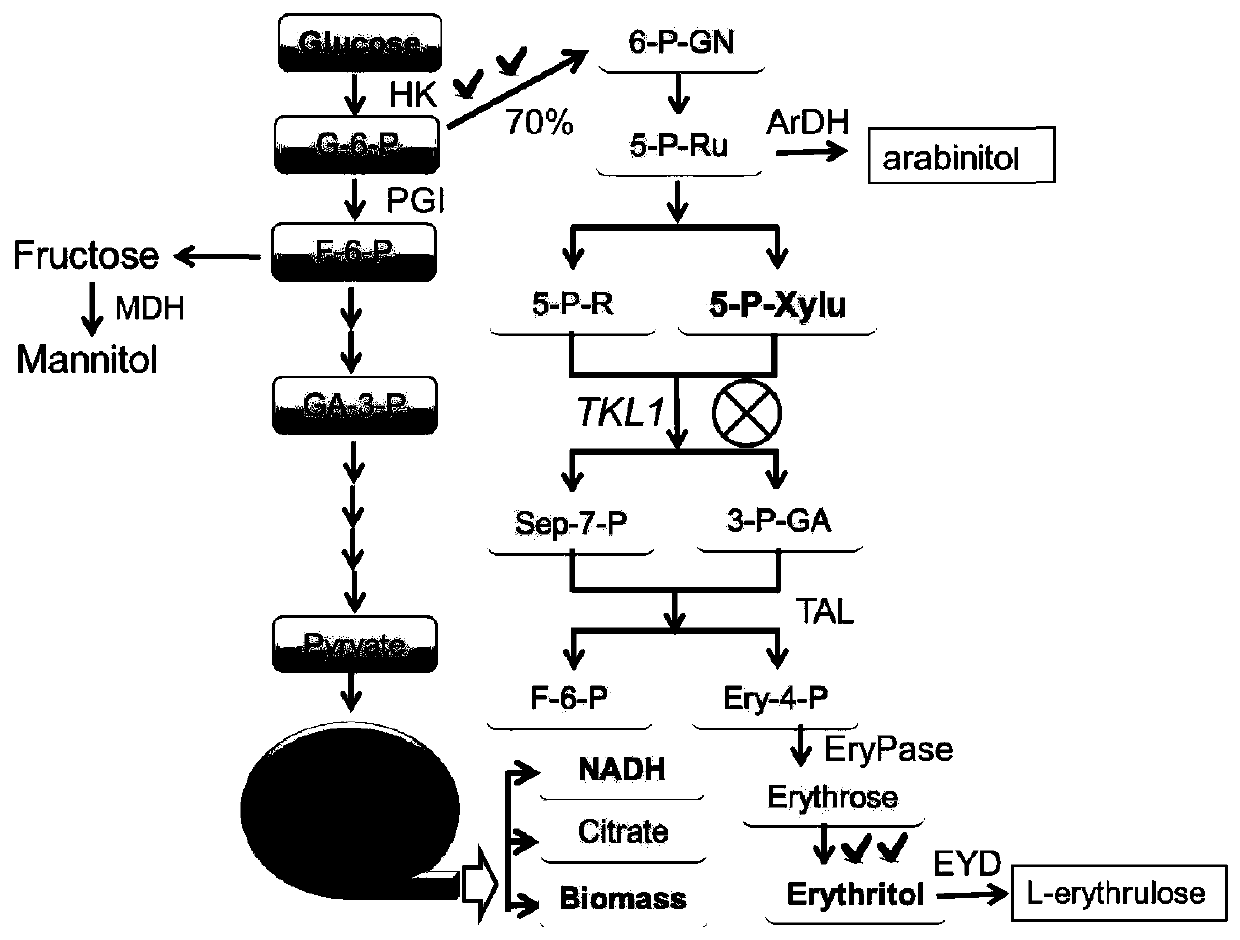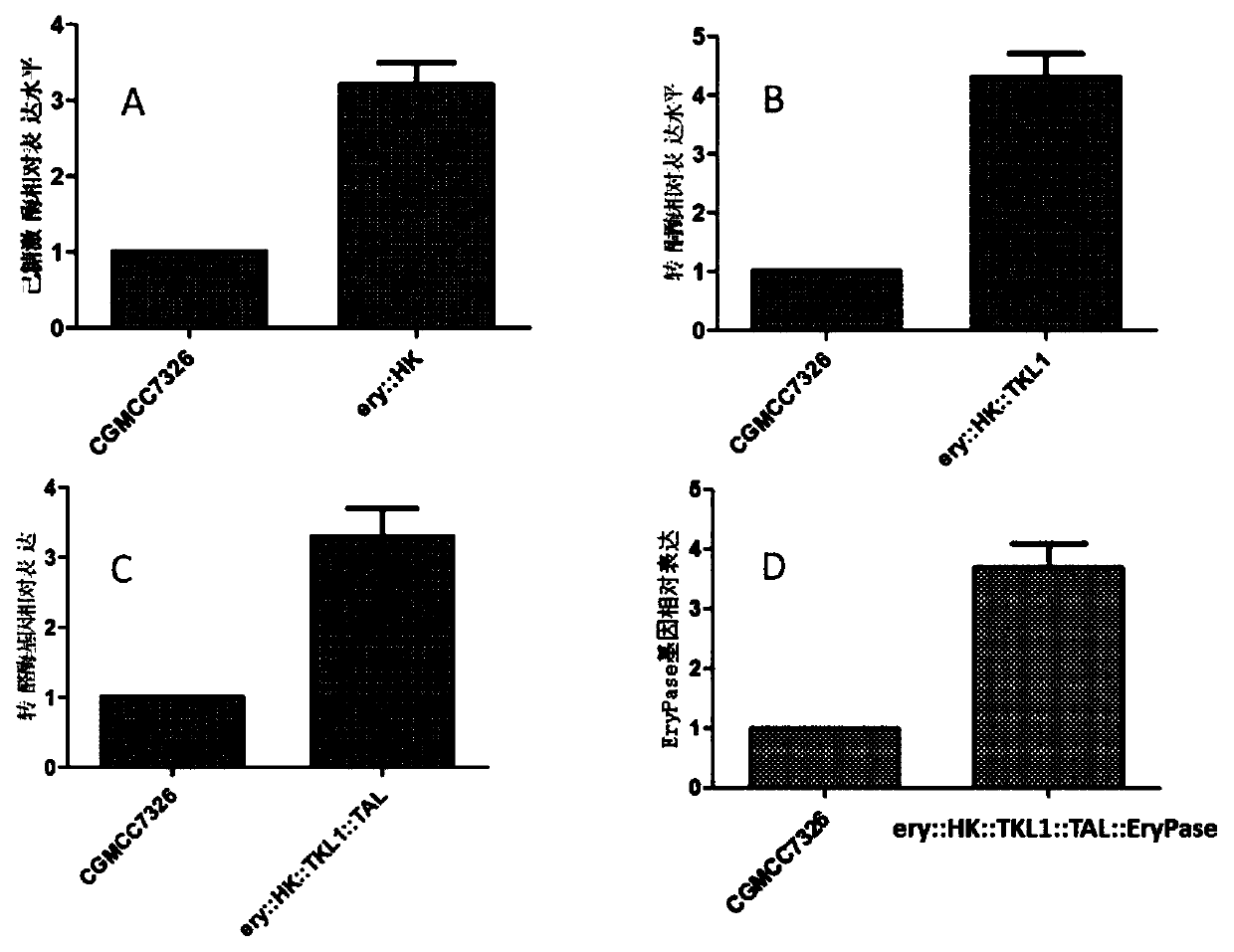Method for constructing recombinant yarrowia lipolytica for synthesizing erythritol and strain of yarrowia lipolytica
A technology of Yarrowia lipolytica and erythritol, which is applied in the field of food biology and can solve problems such as reduced synthetic performance
- Summary
- Abstract
- Description
- Claims
- Application Information
AI Technical Summary
Problems solved by technology
Method used
Image
Examples
Embodiment 1
[0095] Example 1. Overexpression of hexokinase gene in Yarrowia lipolytica
[0096] The hexokinase expression cassette was synthesized according to the following sequence: upstream 26S rDNA sequence → promoter (hp4d) → hexokinase gene sequence → hexokinase terminator sequence → loxP → promoter (TEF) → xylitol dehydrogenase gene sequence → Terminator sequence → loxP → downstream 26S rDNA sequence. The sequence of the synthetic expression cassette containing hexokinase is SEQ ID No.24.
[0097] The schematic diagram of the DNA elements in the integrated expression box constructed containing the hexokinase gene is as follows figure 2 As shown, the hexokinase gene can be derived from the hexokinase gene of Saccharomyces cerevisiae, Pichia stipitis, Binding yeast, Candida sphaeroides, or Yarrowia lipolytica itself. Here, Yarrowia lipolytica is selected Yeast's own hexokinase gene (SEQ ID No. 6). The selection marker can be replaced by an auxotrophic marker such as the ura3 gene, or ...
Embodiment 2
[0100] Example 2. Overexpression of transketolase gene in Yarrowia lipolytica
[0101] Replace the hexokinase gene in Example 1 with the transketolase gene. The rest of the DNA elements can remain unchanged or can be changed accordingly. For example, the promoter sequence can be other promoter sequences, such as the glycerol dehydrogenase gene promoter sequence. Wait. The selection marker xylitol dehydrogenase gene can also be a sucrose hydrolase gene. The sequence of the synthetic expression cassette containing the transketolase gene is SEQ ID No. 25.
[0102] The schematic diagram of the DNA element in the integrated expression box containing the transketolase gene is constructed as Figure 4 As shown, the transketolase gene comes from but is not limited to the following microorganisms: Saccharomyces cerevisiae, Candida magnolia, Pichia stipitis, or Yarrowia lipolytica itself. The transketolase gene TKL1 (SEQ ID No. 10) of Yarrowia lipolytica itself is used here. The methods ...
Embodiment 3
[0107] Example 3. Overexpression of transaldolase gene in Yarrowia lipolytica
[0108] The expression cassette containing the transaldolase gene was synthesized, and its sequence is SEQ ID No.26. The schematic diagram of the DNA element in the integrated expression box containing the transaldolase gene is constructed as Figure 5 Shown. The transaldolase gene comes from but is not limited to the following microorganisms: Pichia stipitis, Candida tropicalis, Komagataella phaffii yeast, Debaryomyces hansenii, Yarrowia lipolytica. The transaldolase gene TAL (SEQ ID No. 11) of Yarrowia lipolytica itself is used here. The methods of DNA transformation, transformant strain screening and selection marker recovery are the same as in Example 1. The chassis strain used can be the transformant ery::HK::TKL1 with overexpression of the hexokinase gene obtained in Example 2, or other strains that can synthesize erythritol (such as the patent previously obtained by the inventor) Strain Yarr...
PUM
 Login to View More
Login to View More Abstract
Description
Claims
Application Information
 Login to View More
Login to View More - R&D
- Intellectual Property
- Life Sciences
- Materials
- Tech Scout
- Unparalleled Data Quality
- Higher Quality Content
- 60% Fewer Hallucinations
Browse by: Latest US Patents, China's latest patents, Technical Efficacy Thesaurus, Application Domain, Technology Topic, Popular Technical Reports.
© 2025 PatSnap. All rights reserved.Legal|Privacy policy|Modern Slavery Act Transparency Statement|Sitemap|About US| Contact US: help@patsnap.com



